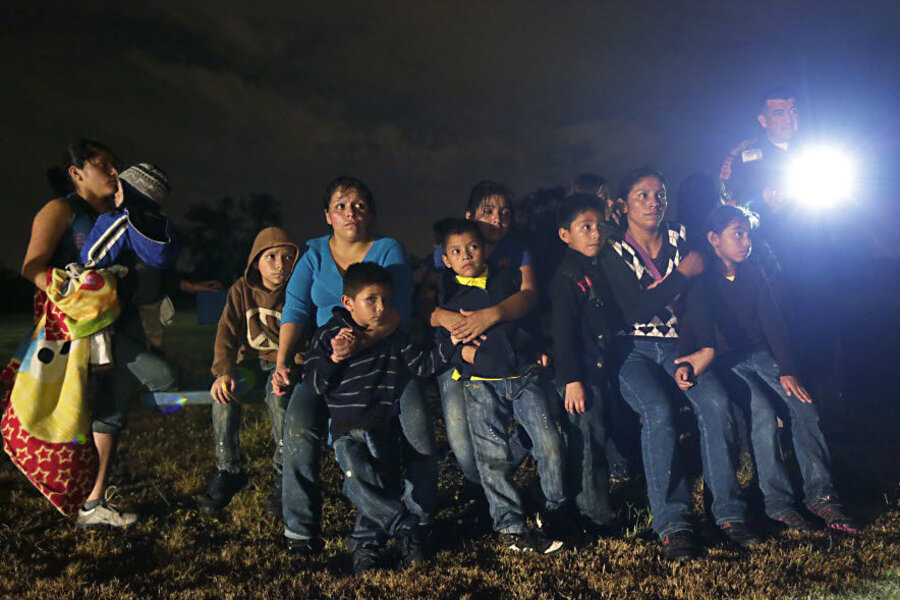Why child migrants head to the US
Loading...
The dramatic increase in unaccompanied child migrants crossing the US-Mexican border this year didn’t develop overnight. What can be done to both keep the more than 57,000 migrant children from Central America safe and halt the flow?
What happened in Central America recently that led to the surge of child migrants?
El Salvador, Guatemala, and Honduras have long had high rates of violence, struggling economies, and lack of opportunity, all of which tend to “push” emigration. Over the past decade, the increased presence of street gangs and organized crime have further exacerbated the situation.
“It’s not like there was a golden age” in the Northern Triangle, as this region is called, says Dana Frank, an expert on Honduran history at the University of California, Santa Cruz. Civil wars raged across Central America throughout the 1970s and ’80s, and economic inequality persists.
These three main countries from which the children are fleeing are among the nations with the top five murder rates in the world (along with Belize and Venezuela), according to the most recent United Nations data. In some cases, such as Guatemala, the homicide rate has actually declined slightly in recent years. But crimes like extortion have become “widespread and intolerable,” says Cynthia Arnson, the Latin America director at the Woodrow Wilson International Center for Scholars. “Everyone is hit, down to the person at the bottom of the informal economy selling chewing gum.”
There are also “pull” factors drawing migrants to the United States. These include family already residing there and “what appears to be a very deliberate effort by human trafficking rings to spread rumors” about US immigration policy for children, Ms. Arnson says.
Who are these children and why are they coming only to the US?
Those counted as child migrants are under the age of 18, and some are coming with children of their own. Many have traversed the porous and increasingly dangerous Guatemalan-Mexican border, ridden deadly freight trains across Mexico, or hired human traffickers to lead them north. All have suffered some kind of trauma, whether it’s extreme weather conditions, threats by gangs, hunger, rape, stress, or injury.
Almost half of the children from Honduras, El Salvador, Guatemala, and Mexico recently interviewed by the United Nations Refugee Agency fled their homes due to violence.
Most of the unaccompanied minors are teens, but those aged 12 and under are part of the fastest growing group crossing the US-Mexican border, according to the Pew Research Center. This cohort more than doubled between 2013 and 2014, reaching 7,461 between October and June this year. Salvador Gutiérrez, an Americas policy officer for the International Organization forMigration says he’s heard reports that armed gangs are targeting children more frequently in Northern Triangle nations.
About 36 percent of the unaccompanied children the UN interviewed had at least one parent residing in the US. Not all of the minors cited this as their primary reason for migrating, however.
Furthermore, applications for asylum in neighboring countries such as Costa Rica and Mexico have shot up in recent years. Mr. Gutiérrez estimates the total number of Northern Triangle migrants seeking asylum in other Central American countries has increased seven fold since 2008.
Are Central American leaders offering solutions?
Honduras and Guatemala are asking for an increase in US aid for security and development across Central America. Guatemalan President Otto Pérez Molina said that if the US used just 10 percent of its border budget in Central America – about $2 billion – it could “attack the root of the problem.” The US has invested $800 million in regional defense in all of Central America since 2008, and there are allegations in each Northern Triangle country of corrupt security officials and collusion between the police and criminal gangs.
Central American leaders are also asking the US to treat their young citizens as refugees. Honduran President Juan Orlando Hernández called for a “clear” US immigration policy as well as an alternative approach to US drug policy, which he says plays a direct role in the violence in Central America.
What are US leaders suggesting as a solution?
President Obama requested $3.7 billion from Congress to address the immigration crisis. If the package passes, the majority of that money will stay in the US, bolstering law enforcement on the border and social services. About $300 million of that package would go to Guatemala, Honduras, and El Salvador. The House of Representatives passed a $694 million border bill Aug. 1, but it is not expected to become law. The Senate began its five-week summer recess without passing its own legislation.
Mexican youths, unlike those from Central America, can be deported on the spot. Some politicians are pushing for a repeal of the 2008 law that slows down deportation for Central American children. Additionally, Mr. Obama said the US would consider a limited refugee program in Central America, which would allow minors to apply for entry before embarking on the dangerous journey north.
What’s at risk when deporting the children from the US?
Deportations have already started on a small scale, and Gutiérrez at the IOM worries that Honduras, El Salvador, and Guatemala won’t be able to absorb a larger influx of child migrants. “There won’t be room at shelters and there may not be enough food,” he says. He estimates around 13,000 children currently have deportation orders from the US.
For many children, the problems they fled – no income, aggressive gang recruitment, extortion, or threats of violence – still await them back home, with few resources to deal with them. In Guatemala, the government spends a smaller percentage of its gross domestic product on social programs than almost any other nation in the hemisphere. “The priority is to reintegrate these children, but there’s a lot of concern over the trauma they have been through,” and if their home countries can provide needed support, Gutiérrez says.








